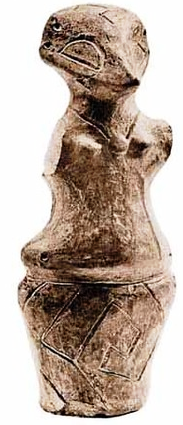The context of Stubline-Crkvine group of Vinca figurines is published in Starinar (Serbia)
Part. 1
L. Nikolova
Source : http://www.examiner.com/world-culture-in-national/resized-crkvine-jpg-photo-1

Crkvine group of figurines. Vinca culture (fifth millennium cal BCE).
Photo: Serbia National review
The Balkans are among the regions with the richest prehistoric cultures in the Balkans (Bailey, 2000; Nikolova, 1999).
The group of figurines unearthed at the prehistoric village of Crkvine, situated in the vicinity of Stubline village (40 km southwest of Belgrade, Serbia), is one of the most interesting discoveries of Vinca culture – the hallmark of the Balkan prehistoric cultures from later sixth - the first half of the fifth millennium cal BCE.
It is amazing that this finding originates from a site - an emblem of the current non-destructive methodology of excavations of prehistoric sites in the Balkans (Crnobrnja, Simic, & Jankovic 2009; Crnobrnja & Simic 2011). In the course of a geophysical investigation the team of Crkvine project was able to document a linear-nuclear planning of the village and destruction of different character.
What did the group of clay figurines mean?
The new data issued in Starinar (Crnobrnja, Simic, & Jankovic 2009 [.pdf file]) clarify that the group of figurines was discovered close to an oven. The figurines are still not published in details, so obviously we need to wait for a new publication to make more detailed hypothesis about its meaning. For the time being, several possible interpretations can be proposed, as a framework of future analysis:
1. A group of figurines made by handcrafters for exchange. The context infers that the group was possibly found in a handcraft house related to pottery production. It will be extremely interesting the publication of Dubravka Nikolic about the pottery found in the house – whether it was household pottery or made for exchange.


2. Story-tellers. We still do not have impressive evidence about story-tellers in the Balkans, which are very popular in the Native American culture. These figurines usually include many persons. The variety of the figurines from Crkvina can be compared with possible stories about different activities and related ancestral history. Then, the largest figurine would be the story-teller accompanied by heroes. This hypothesis does not exclude the first one since the figurines could have been offered as a group.
3. A lineage-genealogical symbolic group. The author mentioned, that the houses were grouped at Crkvine that may have related to a lineage structure. Then, it can be expected very strong kinship rituals in this village. This hypothesis does not exclude the first and second one.
4. A cult group (mentioned by the authors). The weak argument of this hypothesis is very ordinary character of the figurines. The existed one large figurine theoretically makes possible think about a god and heroes having in mind the different instruments as weapons.


5. A game group (mentioned by the authors). Again the weak argument is the non- sophisticated manner of presentation of the figurines in compare to the contemporary chess figurines, for example. One would expect more mythological than everyday elements, like tools, although the axes were probably powerful weapons in prehistory. Also, if the group is complete, the asymmetry looks strange for a game that unusually involves more than one person. Last but not least, the way the tools were attached is very non-stable and would make difficult to play with such figurines. However, the enculturation and socialization in the prehistoric households required multi-aspects means, in which the games were probably of primary importance for the children. The game theory does not exclude the story-tellers, lineage-genealogical and even cult theories, since games are most powerful means for the passing of knowledge from older to younger generation, especially the children.


Part. 2